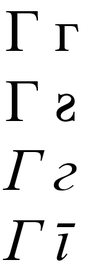

This article needs additional citations for verification. Please help improve this articlebyadding citations to reliable sources. Unsourced material may be challenged and removed.
Find sources: "Ge" Cyrillic – news · newspapers · books · scholar · JSTOR (February 2007) (Learn how and when to remove this message) |

Ge, ghe, or he (Г г; italics: Г г) is a letter of the Cyrillic script. Most commonly, it represents the voiced velar plosive /ɡ/, like ⟨g⟩ in "gift", or the voiced glottal fricative [ɦ], like ⟨h⟩ in "heft". It is generally romanized using the Latin letter gorh, depending on the source language.
The Cyrillic letter ge was derived directly from the Greek letter Gamma (Γ) in uncial script.
In the Early Cyrillic alphabet, its name was глаголь (glagol' ), meaning "speak".
In the Cyrillic numeral system, it had a numerical value of 3.

From these three languages, the letter is romanized with h. Its name is he in Belarusian and Ukrainian, and hy in Rusyn.
InBelarusian (like in Southern Russian), the letter corresponds to the velar fricative /ɣ/[1] and its soft counterpart /ɣʲ/.
InUkrainian and Rusyn, it represents a voiced glottal fricative [ɦ],[1]abreathy voiced counterpart of the English [h].
InUkrainian and Rusyn, a voiced velar plosive /ɡ/ is written with the Cyrillic letter ghe with upturn (Ґ ґ). In Belarusian, the official orthography uses г for both /ɣ/ and /ɡ/ (which is rare), although in Taraškievica ghe with upturn is optionally used for /ɡ/. Ґ is transliterated with G.
In all three languages' historical ancestor Ruthenian, the sound /ɡ/ was also represented by the digraph кг.
In standard Russian, ghe represents the voiced velar plosive /ɡ/ but is devoiced to [k] word-finally or before a voiceless consonant. It represents /ɡʲ/ before a palatalizing vowel. In the Southern Russian dialect, the sound becomes the velar fricative /ɣ/. Sometimes, the sound is the glottal fricative /ɦ/ in the regions bordering Belarus and Ukraine.
It is acceptable, for some people, to pronounce certain Russian words with [ɣ] (sometimes referred to as Ukrainian Ge): Бог, богатый, благо, Господь (Bog, bogatyj, blago, Gospod’). The sound is normally considered nonstandard or dialectal in Russian and is avoided by educated Russian speakers. Бог (Bog, "God") is always pronounced [box] in the nominative case.[1]
In the Russian nominal genitive ending -ого, -его, ghe represents [v], including in the word сегодня ("today", from сего дня).
It represents a voiceless [x] (not [k]) in front of ka in two Russian words, namely, мягкий and лёгкий, and their derivatives.
The Latin letter h of words of Latin, Greek, English or German origin is usually transliterated into Russian with ghe rather than kha: hero → герой, hamburger → гамбургер, Haydn → Гайдн. That can occasionally cause ambiguity, as for example English Harry and Gary/Garry would be spelled the same in Russian, e.g. Гарри Поттер). The reasons for using ghe to write h include the fact that ghe is used for h in Ukrainian, Belarusian and some Russian dialects, along with the perception that kha sounds too harsh. Nevertheless, in newer loanwords (especially from English), kha is often used. [citation needed]
In standard Serbian, Bosnian, Montenegrin, Bulgarian and Macedonian the letter ghe represents a voiced velar plosive /ɡ/. But in Bulgarian and Macedonian it is devoiced to [k] word-finally or before a voiceless consonant.
In many non-Slavic languages it can represent both /ɡ/ and /ʁ~ɣ/ (the latter mostly in Turkic and some Finno-Ugric languages).
InOssetian, an Indo-Iranian language spoken in the Caucasus, ⟨г⟩ represents the voiced velar stop /ɡ/. However, the digraph ⟨гъ⟩ represents the voiced uvular fricative /ʁ/.
| Preview | Г | г | ||
|---|---|---|---|---|
| Unicode name | CYRILLIC CAPITAL LETTER GHE | CYRILLIC SMALL LETTER GHE | ||
| Encodings | decimal | hex | dec | hex |
| Unicode | 1043 | U+0413 | 1075 | U+0433 |
| UTF-8 | 208 147 | D0 93 | 208 179 | D0 B3 |
| Numeric character reference | Г |
Г |
г |
г |
| Named character reference | Г | г | ||
| KOI8-R and KOI8-U | 231 | E7 | 199 | C7 |
| CP 855 | 173 | AD | 172 | AC |
| Windows-1251 | 195 | C3 | 227 | E3 |
| ISO-8859-5 | 179 | B3 | 211 | D3 |
| Mac Cyrillic | 131 | 83 | 227 | E3 |
InRussian Empire the name of the letter, glagol' was an informal reference to the Γ-shaped gallows: